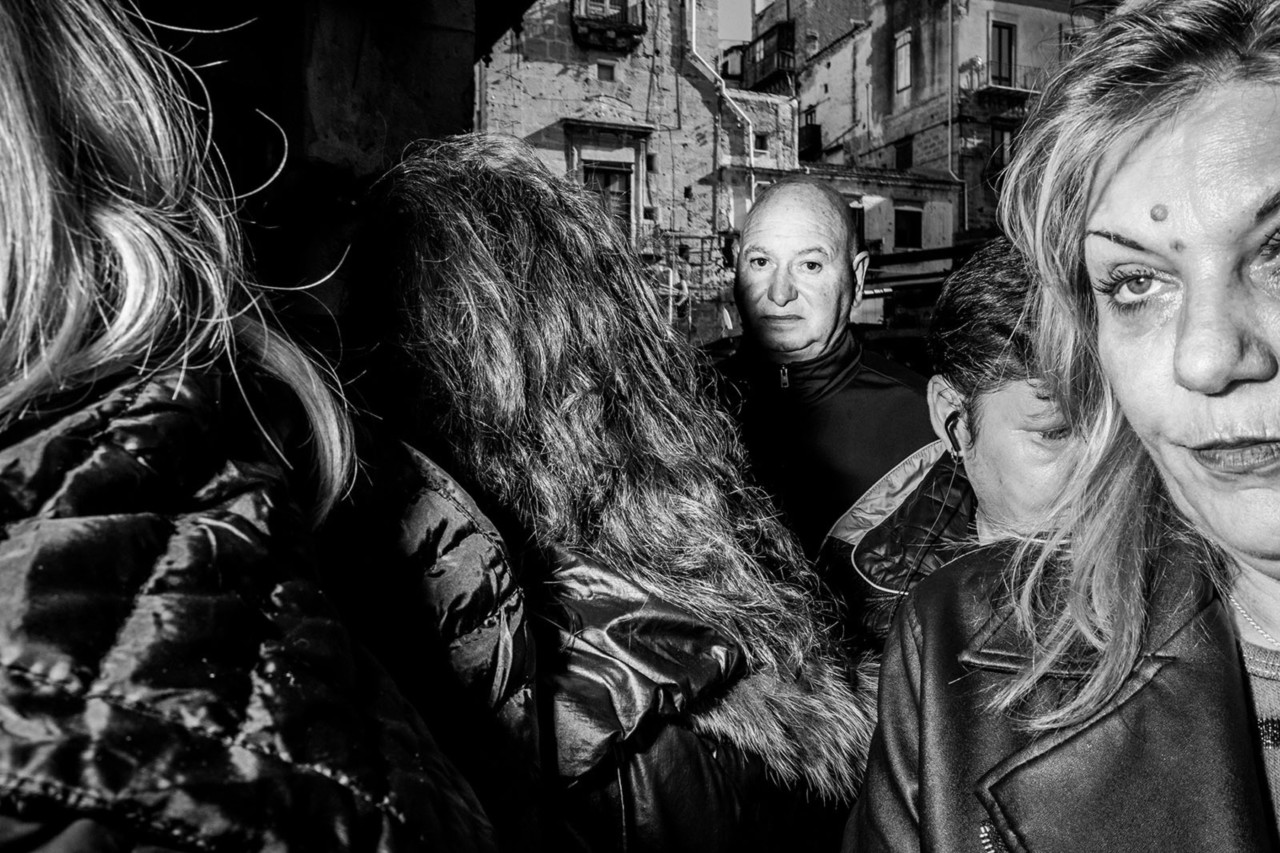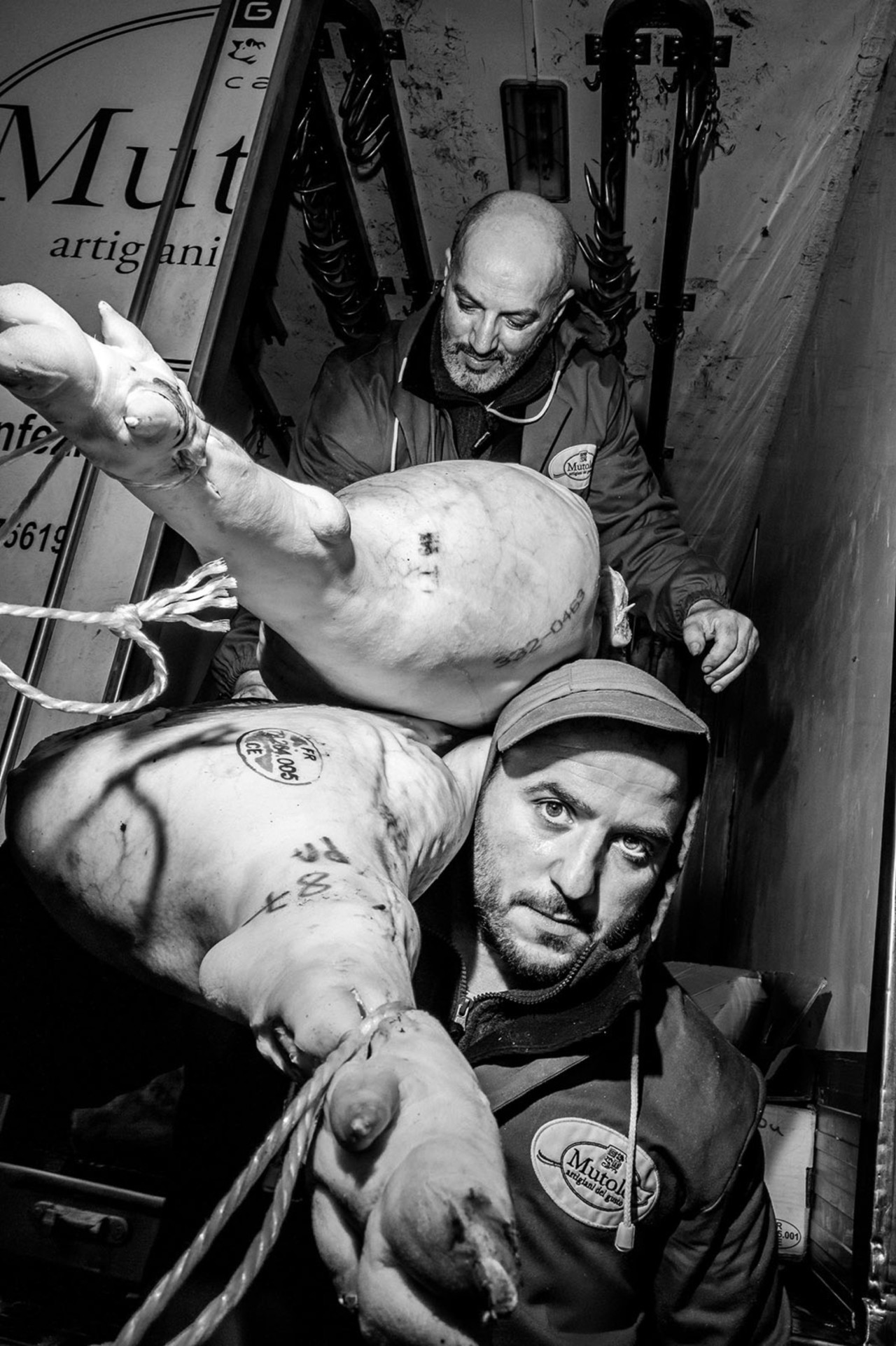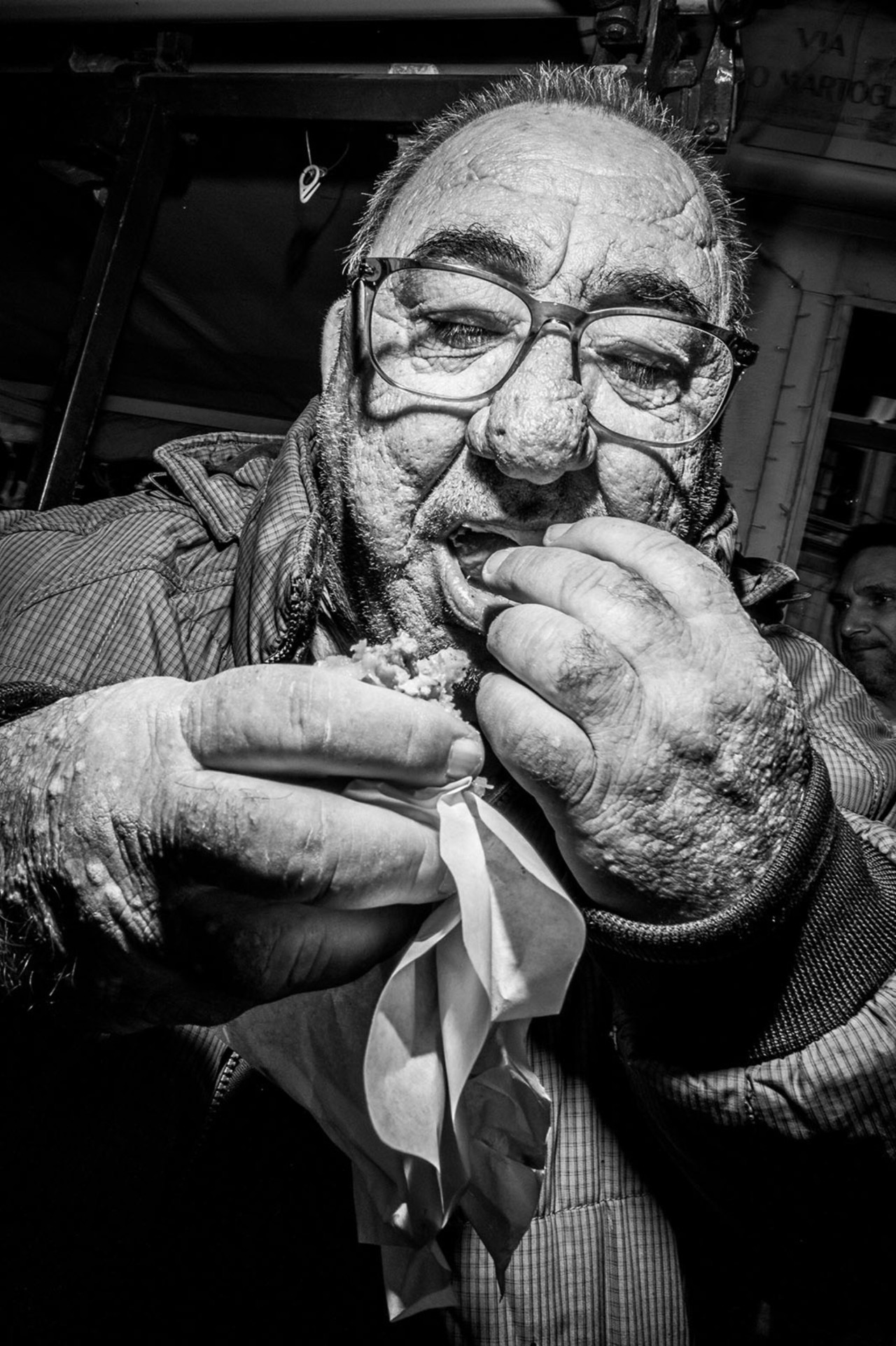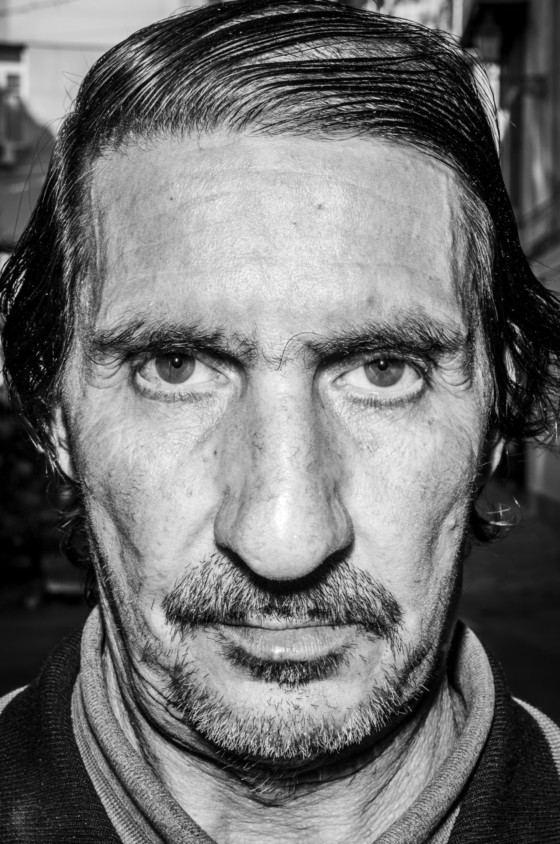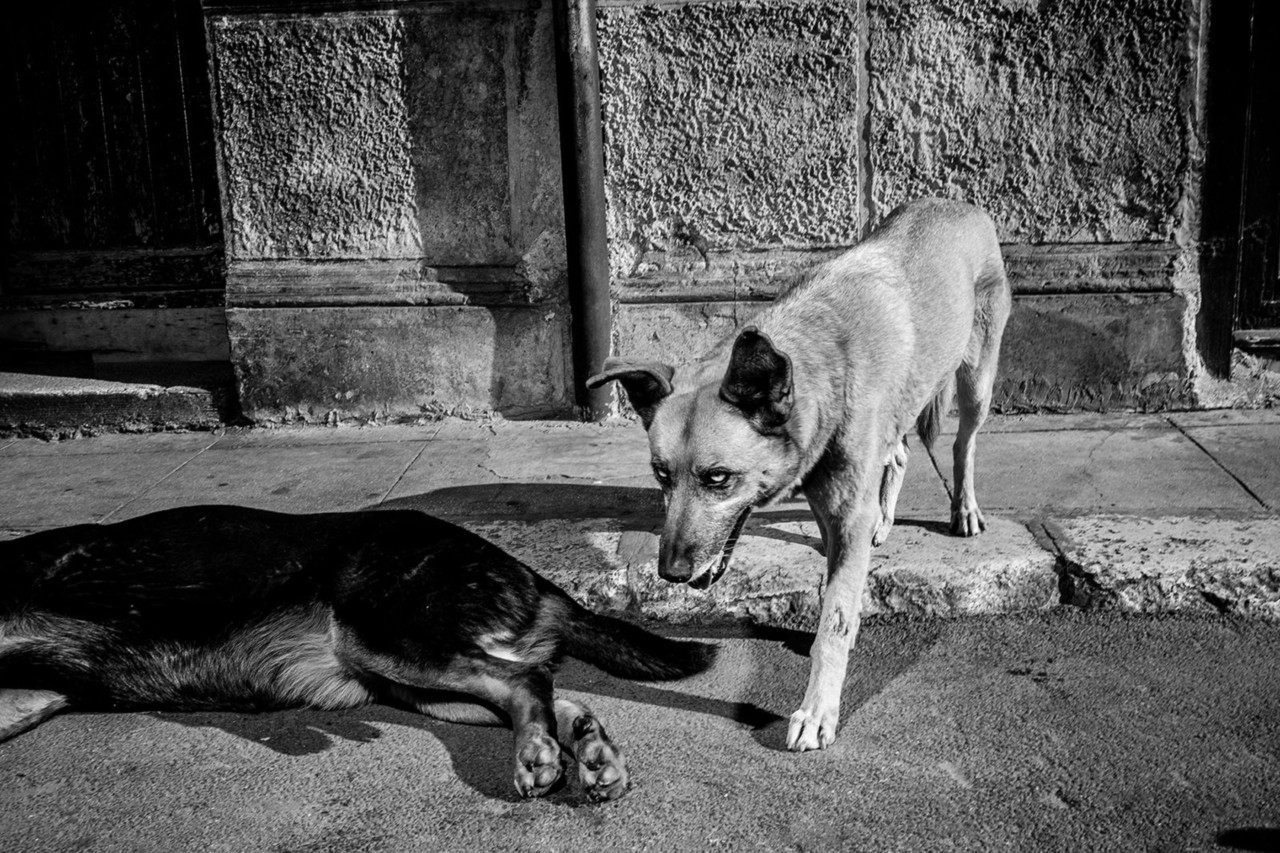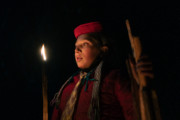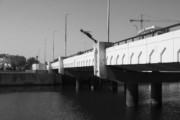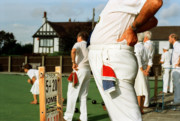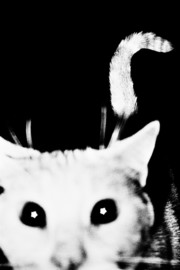Palermo Gilden
Bruce Gilden explains his succinct and energetic approach to shooting his latest book, exploring the Italian city’s famed Ballarò market
Recently published by 89 Books, the limited-edition release Palermo Gilden was the result of a five-day mini-residency Magnum photographer Bruce Gilden took in the Sicilian city in December of 2019. Here, Gilden discusses the allure of Palermo’s Ballarò market, sandwiches made of spleens, plans for a return trip and second book, and the primary importance of doing your homework when it comes to working on deadline in a new location.
How did you come to make a book in Palermo?
I have known Mauro D’Agati, who started and runs 89 Books, for 20-odd years. He wanted me to come to Palermo to do a short four-or-five-day residency, to photograph there, primarily in the Ballarò market: one of the more old-school markets in the city. Anyway, I said yes. I had been wanting to go back to Palermo for some time and I always felt Italy would be a good place to photograph more: I find the people interesting.
As it happened, I got the Gucci lookbook job that winter, for the pre-Fall 2020 collection, and while in Italy I slotted this Palermo outing between shooting the women’s and the men’s lookbooks in Rome. So, I ended up in Palermo in December of 2019.
I was meant to go back early in 2020, to shoot on the beach, but of course that didn’t happen, with the pandemic going on. I now plan to return to the city in July, and to the beach. That will result in a second Palermo book – also to by published by Mauro – that will combine the images from the market and the newer beach photos.
How was the market, on first impression and as a place for you to make work?
I was really excited when I got there. I had to slow myself down at first, and force myself to not rush about not least as I didn’t want to break my neck on the cobblestones. The market had these shiny, uneven cobblestones which were made worse by the water and ice from all the fish… I must have fell on my ass at least three times.
Anyway. I like to work very close, as you know, and the market was very crowded – a good start. Some of the images look like tight crops, but they aren’t — they are like that because you couldn’t back up even if you wanted to. These narrow spaces, where people were coming from all directions were the most interesting to me. Now, I think if you don’t photograph like me – if you aren’t agile, or excited to be in those situations – it would be pretty hard to work there, at least if you were trying to make images right inside the crowds.
This closeness gave me the opportunity to make some good photographs in the way I like most. And the place was packed with characters. The market was also dark – by that I mean that a lot of the areas were dark: narrow spaces, with cloth awnings above, protecting the fish and so on, blocking out the sun. It made the pictures quite dramatic; those characters look almost like actors in a play.
There’s this sandwich people there eat – it’s incredible. It’s called a Pani Ca Meusa – and it’s made of some sort of meat… intestines— no, trachea. Trachea and spleens. It looks awful – it’s not appetizing. You aren’t gonna be like, ‘Wow I want to try that!’ This one guy was eating with one real gusto. It’s a blue-collar thing there, and a lot of the workers were at this stand, shoving these sandwiches in. It’s like how in New Orleans they have the muffeletta, it’s their thing. This one’s a cut above that, in terms of greasy!
"What’s good about these people is that they wear their hearts on their sleeves – like me. I’m not saying they are telling you everything about their lives, but they are open, they talk to you."
- Bruce Gilden
What stood out about the people in the market? You said there were a lot of characters?
What I noticed immediately was that I had a lot of images of women with their mothers, walking arm in arm. Someone once told me – when you go out with a girl you should check out her mother: that’s what you’re in for down the line! You can see a bit of that in some of these pairs. In Palermo, it’s a traditional culture in that way. Seeing this wasn’t a shock or anything. I expected it, because I know Italians – or at least Italian-Americans, but what still stood out to me on a visual level was just how many of these pairs I saw.
In the book I only have three of my ‘faces’ – the close-up portrait images made on the Leica S. There were three strong faces I saw. One guy stood out in particular – a guy who looked like a B-movie actor or something… His hair was perfectly combed, but you could still see he was losing it. It’s all in those details.
What’s good about these people is that they wear their hearts on their sleeves – like me. I’m not saying they are telling you everything about their lives, but they are open, they talk to you.
"People might not agree with my reasoning, but I have 55 years of looking at things. I don’t ask anyone to work like me, see like me, or photograph like me – but I know what I am doing."
- Bruce Gilden
Was it challenging – having a book proposal hanging on only four days shooting in a new place?
No. I have faith in my ability. Seriously, I do.
But that said, it’s also about how you work. What happens when you photograph – at least if you want to do it well – is this: you find certain areas you know are good, where you know what to expect, and you shoot there.
For example – and let’s go back a bit here for a moment – take when I was working in Haiti. Before one trip, when I was going there to shoot the Mardi Gras, I looked at all my previous contact sheets to select the best road junction to stand at. I looked at the contact sheets and picked my spot. Then I decided what I was going to shoot there. I decided I wanted to shoot people watching the floats and so on, not the procession itself, and I did. I went to that location I knew, and took photos of people there, and I got one of my best-ever photos in Haiti.
Here’s the other thing: just walking around, you learn the best times of day to shoot, and you need to learn that people are all different depending where you work and that they will respond differently. In Haiti I photographed in a cemetery, and people were OK with it. Now, you try doing that in New York City without asking – yeah, sure – I’d like to see that!
In short – if you do your homework before, or you take all of this on pretty soon after you arrive, and you don’t run around like a chicken without a head, you help yourself. Of course, plans do change and you have to readjust, but that approach helps.
When I got to the market I learned that you have the traditional area, and also, on the weekend, there’s this more open area perpendicular to the old part where people sell all sorts of crap… Underwear and whatever. So, I knew those areas weren’t as interesting to me because people there were likely to be a bit less crammed together. Next, within that traditional area, I selected those streets where I liked the light, the narrowness I spoke about before, and where the people were flowing across each other. I focused my efforts in those areas. Again – it’s homework. Find that area that’s best and go a hundred times. I’m a bulldog like that.
Anyway, there was enough going on. It’s not like I was being asked to do corporate-type portraits – for that I would need to come up with something really creative to make me interested. Here, it was just there, it was in front of me. I just needed to work out how to get as much as possible in the time I had.
But did knowing you were there such a short time change the images you made do you think?
Take the picture of the two men in the restaurant… Now, if I wasn’t on a four-day commission, maybe that’s not a photo I would take, but I did – and it turned out fine and it makes it into the book. We needed X-amount of pages to print a book, and we need to fill those pages. So that changes the approach to an extent. Maybe some of these images might not be in the book if I had gone on a second trip – but from the days I was there, this was it.
Do you think you are particularly well suited to working this way, with this little time?
I’m a totally visual person. I realize what’s good, what’s not as good, and what’s excellent. Now, people might not agree with my reasoning, but I have 55 years of looking at things. I don’t ask anyone to work like me, see like me, or photograph like me – but I know what I am doing. There are many opinions on photography and a lot of people don’t agree with mine. I have a talent for forming a picture and getting some emotional quality into it – a lot of people don’t have that in their work, and that might affect how they see or judge my work.
The important thing is this: I did a pretty good job. I’m not saying the pictures are all great, but it stands up as a book. I knew what I was doing. I was only there four, five days, but I have to put myself up to the same standard I would if I was there four years. Other people will only see the images: they don’t care if I was there for a long or a little time.
Don’t be afraid of being in a place a short time, take that chance. It’s about how you work and how you feel. I never refuse any assignment, no matter how uninteresting, because I always think I will get something out of it. I will learn something and I will see a new place.


